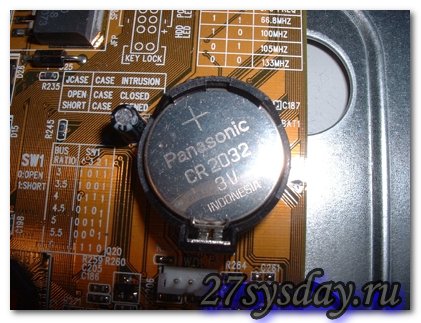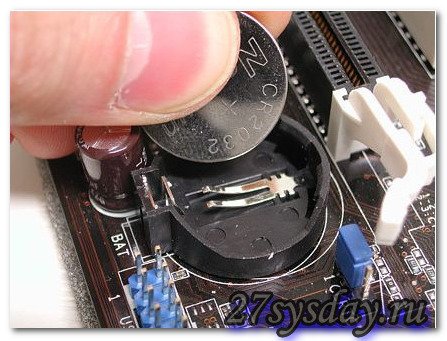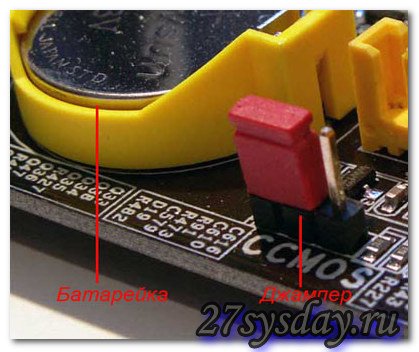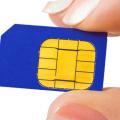Sound signals of the motherboard. AMI BIOS beeps
The topic of this article is BIOS. First, we will deal with the question of what is BIOS and what is it for? And then we will describe the BIOS sound signals in as much detail as possible.
BIOS (Basic Input-Output System) is a special program that is stored in a ROM (read only memory) chip. The English language designation for this type of memory is often found - Read Only Memory, or ROM for short. In practice, instead of conventional ROM chips, Flash memory has been used for a long time, which is rewritable, which allows the user to independently update the BIOS versions.
BIOS functions
As for the BIOS functions, they are quite extensive.
Firstly, as soon as the PC is powered on, control immediately goes to the BIOS. This program performs initial testing of the components. system unit... After a successful check, the BIOS transfers control of the computer to the next program, which is written in the Boot sector (boot sector) located on the boot disk (as boot disk can act HDD, CD-disk, floppy disk, flash drive, etc.). The initial equipment testing procedure is called POST (Power-On Self Test).
Secondly, thanks to the BIOS, the hardware configuration of the computer is saved in a special CMOS chip. When the PC is powered on, a comparison is made between the current hardware configuration and the one stored in the microcircuit. If the program finds differences between these two configurations, then the CMOS memory data will be updated and, if necessary, it will be prompted to enter BIOS Setup to specify the new parameters of the detected hardware. If differences in configurations are not found, or if the configuration update can be performed without user intervention, then the program performs required settings(configuring) the hardware components of the computer.
CMOS memory (Complementary Metal Oxide Semiconductor) is small in size random access memory microcircuit (RAM or RAM - Random Access Memory). But since there is a need to save information in it even after turning off the power, the CMOS memory is additionally powered by its own battery. Several problems are associated with this very battery. One of them is a limited service life, which is 5-6 years. After the expiration of this period of time, the battery can no longer provide the required level of power, which leads to the loss of the stored information in the microcircuit. Although this problem is solved quite simply - a new battery is installed.

Thirdly, with the help special program BIOS Setup the user can set various parameters and select operating modes for individual PC components. Here, the user can turn off the equipment that is not in use, or its use is undesirable in order to ensure the safety of the computer. Fourth, the BIOS handles I / O operations. Actually for the sake of this, this system was originally developed. Thanks to the presence of BIOS, for example, the hard disk understands that the head needs to be placed on a specific track or to read a specific sector, etc.
If all programs had to contain instructions of this kind, then in this case they would be huge, and their work would be very ineffective. In addition, with the advent of each new device, they would have to be modified. Therefore, in order to avoid such problems, a significant part of the work related to processing I / O operations was assigned to the BIOS. Naturally, the BIOS did not solve absolutely all the problems, but it significantly simplified the solution of most of them. It should be noted that today this is no longer as relevant as in the days operating system MS-DOS. Modern operating systems such as Windows XP, Windows Vista, or Windows Seven barely use the BIOS to handle I / O. But here it is imperative to say that everything that has been said is very conditional. In fact, all tasks are performed by the operating system in close interaction with the BIOS, complementing each other functionally.
An ordinary user often has to deal with that part of the BIOS, which is called BIOS Setup. BIOS Setup is a special subroutine that allows you to configure the operation of individual hardware components of your computer. The main difficulty in setting it up lies in the incomprehensible names of the options, which can say little to a not too advanced user. In addition, the problem is exacerbated by an insufficient amount of reference material on these settings. And if we look at it as a whole, then BIOS Setup is nothing special, the only thing that sets it apart from other programs is a rather archaic interface in comparison with modern operating systems. All settings made by the user during computer setup via BIOS Setup are saved in the CMOS memory chip, where they are stored along with the system hardware configuration data.
How to reset BIOS settings
Below we will give several ways that help solve the problems with resetting the BIOS, that is, returning it to its original state, in which all the settings will be the same as they were before the changes made by the user. Often, such a simple operation as resetting the BIOS settings allows you to eliminate a number of problems with starting your computer, and also helps to avoid visiting a service center.
Method 1
We return the BIOS to the factory default settings using the BIOS setup interface, which will allow us not to disassemble the system unit again. It should be noted that this way feasible in cases where the BIOS is loaded. To reset the BIOS, you need to find the load bios defaults item or load setup defaults in the menu, as shown in the figure and press Enter.

Method 2
Reset BIOS settings using a battery. Before starting, you should completely disconnect the power from the computer. After you make sure that all the cords are unplugged, you need to remove the side cover of the system unit. Next, find the very same battery and take it out for 5-10 minutes. After this period, you can return it to its place. BIOS should reset to zero.

Method 3
Resetting BIOS settings using a jumper (jumper). Finding the jumper on the motherboard is easy, it is almost always next to the battery. It is designated as Clear CMOS or Clear RTS. Sometimes, to make it easier to access, motherboard manufacturers place it near the edge of the board. To reset the BIOS settings, the jumper must be rearranged for a few seconds from position 1-2 to position 2-3, and then return it to its place.

If everything is done correctly, after turning on the computer, after a few seconds, one short signal will be heard - this indicates that the system is in order and then the operating system will start loading. If the system detects hardware problems, the signal will look different. By the type of signal, it is possible to determine what kind of malfunction is detected, and what further actions should be undertaken. All BIOS signals (provided by the speaker) are distinguished depending on its version and, of course, depending on the nature of the detected malfunction. The BIOS version is determined based on the documentation that comes with motherboard... If the documents are missing for some reason, then you can determine the BIOS version using special utilities, which are available in abundance on the Internet. Another BIOS version is usually displayed on the monitor screen at computer startup in the lower left corner. Of all the BIOS manufacturers on the market, two main competitors should be distinguished, software which the vast majority of modern PCs are equipped with. These are two such well-known brands as American Megatrends (AMI) and Award Software. So first, let's look at the AMI audible alarm.
BIOS beeps: AMI BIOS
- - Two short beeps from the speaker mean some malfunction in the computer's RAM. Troubleshooting options: it is necessary to remove the memory module from the slot, wipe it with a dry brush and insert the module into place, if after starting the PC the signals are repeated, then further testing of the memory or its complete replacement may be required;
- - Three consecutive short beeps from the speaker mean an error in reading the first 64 KB of the PC main memory. Troubleshooting options: it is necessary to remove the memory module from the slot, if there is dust, wipe the bar with a dry brush and insert the module into place; if the signals repeat, you may need to further test the memory or replace it completely;

- - Four consecutive short beeps from the speaker indicate a malfunction system timer... Troubleshooting options: reboot the PC, and if the signals are repeated, then repair or replace the motherboard;
- - Five consecutive short beeps from the speaker indicate a CPU malfunction. Troubleshooting options: reboot the PC, if the signals repeat, replace the processor;
- - Six consecutive short beeps from the speaker indicate a malfunctioning keyboard controller. Troubleshooting options: check the cable and connection of the keyboard to the system unit, check the keyboard on another computer. If, after checking, it turns out that the keyboard is in good working order, then the repair option remains motherboard, or its replacement;
- - Seven consecutive short beeps from the speaker indicate a faulty motherboard. Troubleshooting options: reboot and if the signals are repeated, then repair or purchase of a new motherboard will be required;
- - Eight consecutive short beeps from the speaker indicate a malfunction of the graphics card memory. Troubleshooting options: if the signals are repeated after a reboot, either the repair of the old one or the purchase of a new video card will be required;
- - Nine consecutive short beeps indicate a malfunction of the BIOS chips... Troubleshooting options: flashing the microcircuit or completely replacing it;
- - Ten consecutive short beeps from the speaker indicate the impossibility of recording to the CMOS memory. Troubleshooting options: Reset the CMOS memory using one of the above options. If after setting BIOS default values the signals are repeated, then the CMOS memory module needs to be replaced;
- - Eleven consecutive short beeps from the speaker indicate a malfunction of the RAM. Troubleshooting options: it is necessary to remove the memory module from the slot, if there is dust, wipe the bar with a dry brush and insert the module into place; if the signals repeat, you may need to further test the memory or replace it completely;
- - One long and three short beeps from the speaker, as well as one long and eight short beeps, again indicate a malfunction of the video card. Troubleshooting options are the same as in the previous case.
- - The absence of speaker signals may indicate a malfunction of the power supply. Troubleshooting options: check the attachment of the power supply plugs to the connectors on the motherboard, clean the power supply from dust. If these actions do not work, if possible, try to test the power supply unit on another computer. With such symptoms, you will either need to repair it or buy a new power supply.
BIOS beeps: Award BIOS
- - One short signal from the speaker means that there are no errors in the system and the computer is in a fully functional state;
- - Two consecutive short beeps from the speaker indicate the detection of "insignificant" errors. Troubleshooting options: you need to check the reliability of fastening the components and cables to the PC motherboard, then try to set the BIOS to default values;

- - A short repetitive signal from the speaker indicates a power supply malfunction. Troubleshooting options: check the attachment of the power supply plugs to the connectors on the motherboard, clean the power supply from dust. If these actions do not work, if possible, try to test the power supply unit on another computer. With such symptoms, either its repair or the purchase of a new power supply unit will be required;
- - A long repetitive beep from the speaker indicates a malfunction of the RAM. Troubleshooting options: it is necessary to remove the memory module from the slot, if there is dust, wipe the bar with a dry brush and insert the module into place; if the signals repeat, you may need to further test the memory or replace it completely;
- - Three long signal speaker indicate a malfunction of the keyboard controller. Troubleshooting options: check the cable and connection of the keyboard to the system unit, check the keyboard on another computer. If, after checking, it turns out that the keyboard is in good working order, then there remains the option of repairing the motherboard, or replacing it;
- - One long and one short speaker beeps indicate a malfunction of the RAM. Troubleshooting options: it is necessary to remove the memory module from the slot, if there is dust, wipe the bar with a dry brush and insert the module into place; if the signals repeat, you may need to further test the memory or replace it completely;
- - One long and two short beeps from the speaker indicate a malfunction of the video card. Troubleshooting options: you need to check the cable going from the video card to the monitor, if the cable is ok, you need to remove the video card from the slot, wipe it, if necessary, from dust and insert it back. If these actions do not work, then you may need to repair or purchase a new video card;
- - One long and three short speaker beeps indicate a malfunctioning keyboard controller. Troubleshooting options: check the cable and connection of the keyboard to the system unit, check the keyboard on another computer. If, after checking, it turns out that the keyboard is in good working order, then there remains the option of repairing the motherboard, or replacing it;
- - One long and nine consecutive short beeps from the speaker indicate a malfunction of the BIOS chip itself. Troubleshooting options: flashing the microcircuit or completely replacing it;
- - The absence of speaker signals may indicate a malfunction of the power supply. Troubleshooting options: check the attachment of the power supply plugs to the connectors on the motherboard, clean the power supply from dust. If, as a result of the actions taken, when you try to turn the computer back on, the power supply needs to be repaired.
Separately, it is necessary to note the continuous sound signals of the BIOS that change in tonality. This can be caused either by a faulty power supply unit or by overheating of the PC.
Computer crashes and errors
We turn on the computer ... but it does not turn on. All panic! Many do just that, immediately panicking, and thinking it up is not clear what. But the important thing to remember here is this.
When the computer is turned on, a diagnostic program is launched every time Power-On-Self-Test (POST), which checks the most important components of the computer (from the central processor to the keyboard controller).
The test results are output to the computer speaker in the form of a special sound signal. I think you heard at least one peak, but did not attach any importance to it. So these signals allow you to see the direction of where to dig, where to look for a problem.
Since the manufacturer BIOS if not one, then the sound signals are different for each of them. Further, I give the decoding of the signals of some manufacturers.
Award BIOS
| 1 short beep | no errors found |
| No signals | |
| Continuous signal | defective power supply |
| 2 short beeps | minor errors. It is necessary to check the reliability of the connectors of the cables in the connectors of IDE / SATA controllers on the motherboard and on hard drives |
| 3 long beeps | keyboard controller error. Replacement of the motherboard may be needed. |
| 1 long and 1 short beeps | |
| found problems with the video adapter | |
| keyboard initialization error | |
| 1 long and 9 short beeps | error when reading data from a read-only memory chip |
| 1 long repeating beep | incorrect installation of memory modules |
| 1 short repeating signal | power supply problems |
AMI BIOS
| 1 short beep | no errors found |
| No signals | defective or not connected to the motherboard power supply |
| 2 short beeps | RAM problems found |
| 3 short beeps | main memory error (first 64 KB) |
| 4 short beeps | faulty system timer |
| 5 short beeps | defective central processor |
| 6 short beeps | faulty keyboard controller |
| 7 short beeps | defective motherboard |
| 8 short beeps | problems with the video adapter |
| 9 short beeps | |
| 10 short beeps | unable to write to CMOS memory |
| 11 short beeps | faulty external cache |
| 1 long and 2 short beeps | defective video adapter |
| 1 long and 3 short beeps | defective video adapter |
| 1 long and 8 short beeps | problems with the video adapter or the monitor is not connected |
Phoenix BIOS
| 1-1-3 | error writing / reading CMOS data |
| 1-1-4 | checksum error of the contents of the BIOS chip |
| 1-2-1 | defective motherboard |
| 1-2-2 | DMA controller initialization error |
| 1-2-3 | error when trying to read / write to one of the DMA channels |
| 1-3-1 | RAM problem detected |
| 1-3-3 | |
| 1-3-4 | error when testing the first 64 KB of RAM |
| 1-4-1 | defective motherboard |
| 1-4-2 | RAM problems found |
| 1-4-3 | system timer error |
| 1-4-4 | I / O port access error. The error can be caused by a peripheral device using this port for its work. |
| 3-1-1 | error initializing the second DMA channel |
| 3-1-2 | error initializing the first DMA channel |
| 3-1-4 | defective motherboard |
| 3-2-4 | keyboard controller error |
| 3-3-4 | error while testing video memory |
| 4-2-1 | system timer error |
| 4-2-3 | error during the operation of the A20 line. Faulty keyboard controller |
| 4-2-4 | error when working in protected mode. Possibly defective central processing unit |
| 4-3-1 | error while testing RAM |
| 4-3-4 | real time clock error |
| 4-4-1 | serial port test error. May be caused by a device using the serial port for its operation |
| 4-4-2 | parallel port test error. May be caused by a device using the parallel port for its operation |
| 4-4-3 | error while testing math coprocessor |
When you turn on a working PC, after a few seconds, one short beep is heard, which should please the ear of any user ...
This speaker of the system unit signals to you that the self-test was successful, no malfunctions were found, and the operating system starts loading.
If any problems are found, the BIOS chip will generate appropriate beeps in the system speaker.
The nature and sequence of these signals depends on the BIOS version.
What do the beeps mean when I turn on my computer?
Award BIOS:
1. There are no signals - the power supply unit (PSU) is faulty or not connected to the motherboard.
Remove dust from it.
Check that the power pad is securely attached to the motherboard.
If it does not help, replacement or repair of the power supply unit is required.
2. Continuous signal - power supply is faulty. See item 1.
3. 1 short signal - no errors were found, the PC is working properly.
4. 1 short repetitive signal - problems with the power supply. See item 1.
5. 1 long repeating signal - malfunction of the RAM. Try removing the RAM module from the slot and reinserting it. If it doesn't help, replace it.
6. 2 short beeps - minor errors detected. Check that the cables and cables are securely fastened to the motherboard connectors. Set the BIOS to default values (Load BIOS Defaults).
7. 3 long beeps - keyboard controller malfunction. Check the integrity of the keyboard cable and the quality of the connections. Test the keyboard on a known good PC. If it does not help, you will need to repair or replace the motherboard.
8. 1 long and 1 short signals - a malfunction of the RAM. See item 5.
9. 1 long and 2 short signals - video card malfunction. It is recommended to remove the video card and reinsert it. Check the integrity and quality of the monitor cable connection. If it does not help, replace the video card.
10. 1 long and 3 short beeps - keyboard malfunction. See item 7.
11. 1 long and 9 short beeps - error while reading data from the BIOS chip.
Rewriting (flashing) of the microcircuit is required. If it does not help, replace the microcircuit.
AMI BIOS:
1. There are no signals - the power supply unit (PSU) is faulty or not connected to the motherboard. Remove dust from it. Check that the power pad is securely attached to the motherboard. If it does not help, replacement or repair of the power supply unit is required.
2. 1 short signal - no errors were found, the PC is working properly.
3. 2 short signals - malfunction of the RAM. Try removing the RAM module from the slot and reinserting it. If it doesn't help, replace it.
4. 3 short signals - error of the first 64 KB of main memory. See item 3.
5. 4 short signals - malfunction of the system timer. Reboot your PC. If it does not help, you will need to repair or replace the motherboard.
6. 5 short signals - central processor malfunction. Reboot your PC. If it does not help, you will need to replace the processor.
7. 6 short signals - keyboard controller malfunction. Check the integrity of the keyboard cable and the tightness of the connections. Test the keyboard on a known good PC. If it does not help, you will need to repair or replace the motherboard.
8. 7 short signals - motherboard malfunction. Reboot your PC. If it does not help, you will need to repair or replace the motherboard.
9. 8 short signals - malfunction of the RAM of the video card. Reboot your PC. If it does not help, replace the video card.
10. 9 short beeps - an error while checking the checksum of the BIOS chip. Rewriting (flashing) of the microcircuit is required. If it does not help, replace the microcircuit.
11. 10 short beeps - it is impossible to write to CMOS-memory. Reset the contents of the memory (to do this, turn off the PC, unplug the network cable. Find the switch next to the CMOS-memory battery, set it to the Clear CMOS position. Press - with the power off network cable! - PC power button. Set the switch to its original position. If there is no switch on your motherboard, remove the battery for half an hour). Set the BIOS to default values (Load BIOS Defaults). If it does not help, replace the microcircuit.
12. 11 short signals - malfunction of the RAM. See item 3.
13. 1 long and 2 short signals - video card malfunction. It is recommended to remove the video card and reinsert it. Check the integrity and quality of the monitor cable connection. If it does not help, replace the video card.
14. 1 long and 3 short signals - video card malfunction. See item 13.
15. 1 long and 8 short signals - video card malfunction. See item 13.
Phoenix BIOS signals:
1-1-3. Error writing / reading CMOS data.
1-1-4. Checksum error of the contents of the BIOS chip.
1-2-1. The motherboard is defective.
1-2-2. DMA controller initialization error.
1-2-3. An error occurred while trying to read / write to one of the DMA channels.
1-3-1. RAM regeneration error.
1-3-3. An error occurred while testing the first 64 KB of RAM.
1-3-4. Similar to the previous one.
1-4-1. The motherboard is defective.
1-4-2. RAM test error.
1-4-3. System timer error.
1-4-4. I / O port access error.
2-x-x. Problems with the first 64k memory (x - from 1 to 4)
3-1-1. Error initializing the second DMA channel.
3-1-2. Failed to initialize the first DMA channel.
3-1-4. The motherboard is defective.
3-2-4. Keyboard controller error.
3-3-4. Video memory testing error.
4-2-1. System timer error.
4-2-3. Line error A20. Defective keyboard controller.
4-2-4. An error occurred while working in protected mode. The central processor may be defective.
4-3-1. An error occurred while testing the RAM.
4-3-4. Real time clock error.
4-4-1. Serial port test error. May be caused by a device using this port.
4-4-2. An error occurred while testing the parallel port. See above.
4-4-3. An error occurred while testing the math coprocessor.
Attention!!!
1. If you do not feel yourself sufficiently prepared, in case of problems - contact the specialists.
2. Perform all manipulations with the "hardware" with the power off!
3. Before repairing your PC, you must discharge the electrostatic charge (for example, by touching the nickel-plated surface of the faucet with both hands).
4. Even after removing the electrostatic charge, try, if possible, not to touch the pins of the central microprocessor, video adapter processor and other microcircuits.
5. Do not clean the oxidized gold-plated contacts of the video card and RAM modules with abrasive materials! For these purposes, you can use a rubber band like "eraser".
6. Remember that most of the "malfunctions" of the PC are "healed" by a simple reboot!
7. If you do not know which BIOS manufacturer is installed on your PC, look at the top line on the monitor screen during boot, for example, for Award there will be a line like Award Modular BIOS, for AMI - American Megatrends, Inc. The BIOS version must also be indicated in the passport of your PC.
 Wireless Charging Smartphones A5 Supports Wireless Charging
Wireless Charging Smartphones A5 Supports Wireless Charging Why do not MTS sms come to the phone?
Why do not MTS sms come to the phone? Why do you need a full factory reset on Android or how to return Android to factory settings
Why do you need a full factory reset on Android or how to return Android to factory settings